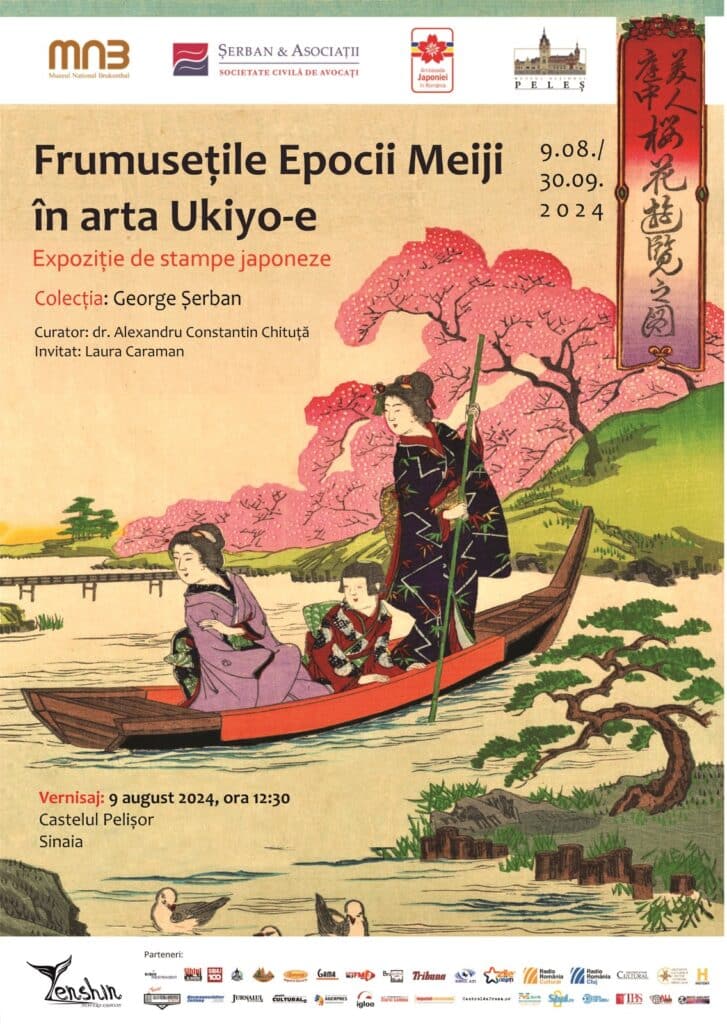exhibition ,,The Beauties of the Meiji Era in Ukiyo-E Art"
George Șerban Collection
Peleș National Museum, Pelișor Castle, rail
Opening: August 9, 2024, 12:30 p.m.
Curator: Dr. Alexandru Constantin Chituță
Guest: Laura Caraman
Exhibition organized by the Peleș National Museum, National Museum BRukenthal with the support of Șerban și Asociații, a civil law society in partnership with the Embassy of Japan in Romania.
The word ukiyo originally expressed the Buddhist idea of the transient nature of life. This rather pessimistic notion was overturned during the period Edo. The character that means to float was replaced by the homonym which meansUm evanescent to express an attitude of joy of lifeThis culture hedhonest man who glorifies life in floating world was particularly well expressed in the production of woodblock prints, which made captivating images of seductive courtesans, exciting kabuki actors, and famous romantic landscapes available to anyone with a little extra money. For the first time, artists were inspired and responded to the interests and preferences of the general public. Ukiyo-e represents the final phase in the long evolution of Japanese genre painting. Building on earlier developments that had focused on human figures, ukiyo-e painters focused on pleasant activities in landscapes, depicted up close, with particular attention to contemporary business and fashion. As artists chose subjects increasingly involved in the pleasures of urban life, their interest turned to indoor activities. The most popular subjects for painting in the early 17th century were scenes of revelry in pleasure houses, especially in the famous Yoshiwara district of Edo.
The Edo period (1603-1868) ends with the resignation of the last shogun, Yoshinobu Tokugawa, in 1868, and the 16-year-old Emperor Mutsuhito, later known as Meiji, now returns to the political leadership of Japan, after a long period in which he played a secondary, more honorary and religious role. Emperor Meiji moved his permanent residence from Kyoto to Edo, which was renamed Toyko. The political and social reforms of the Meiji era have were radical and have ofcome quickly a true revolution, to beThe Meiji Constitution is introduced. IMPAthe rat was declared sacred and inviolableAt END19th century, the signs modernization Japan, after Western models were seen everywhere, such as: the formation of a national army, industrialization, transport and communications (appear S railways, trams), telegraph lines, street lighting of factories and buildings public, and most Japanese have their changed their attire, moving from the traditional kimono to Western clothing. For ukiyo-e artists and publishers of that periodUm, the country's transition allowed them toUm use the new colors made from dyes of anilineUm ANDand pigments which were importantfrom Germany ANDand others yourcountries ANDand created new genres of woodcuts. Images of strange aliens and their technical achievements became popular, ANDPrints were made showing the transformations of the new era – spectacular new stone buildings, steam engines, locomotives, steel bridges and trams on the streets of Tokyo.
The Meiji Emperor and his family began to be portrayed (including for propaganda purposes) by Japanese artists in various official and family poses. They were now dressed in Western costumes and were captured participating in various official activities, exhibitions, or relaxing in nature, accompanied by their female entourage.
The exhibition brings to the public the most important Japanese artists who lived in the Meiji Era and who made Japanese woodblock printsis with beautiful women, courtesans and geisha: Toyohara KUNICHIKA (1835-1900), Utagawa KUNISADA III (1848-1920), Toyohara CHIKANOBU (1838-1912), Tsukioka YOSHITOSHI (1839-1892), Adachi GINKO (active 1874-1902), Ogata GEKKO (1859-1920), Mizuno TOSHIKATA (1866-1908), Utagawa TOYONOBU (1859-1886), Utagawa YOSHIIKU (1833-1904), Utagawa YOSHITAKI (1841-1899), Goyo Hashiguchi (1888-1921), Watanabe NOBUKAZU (1872-1944) and others.
